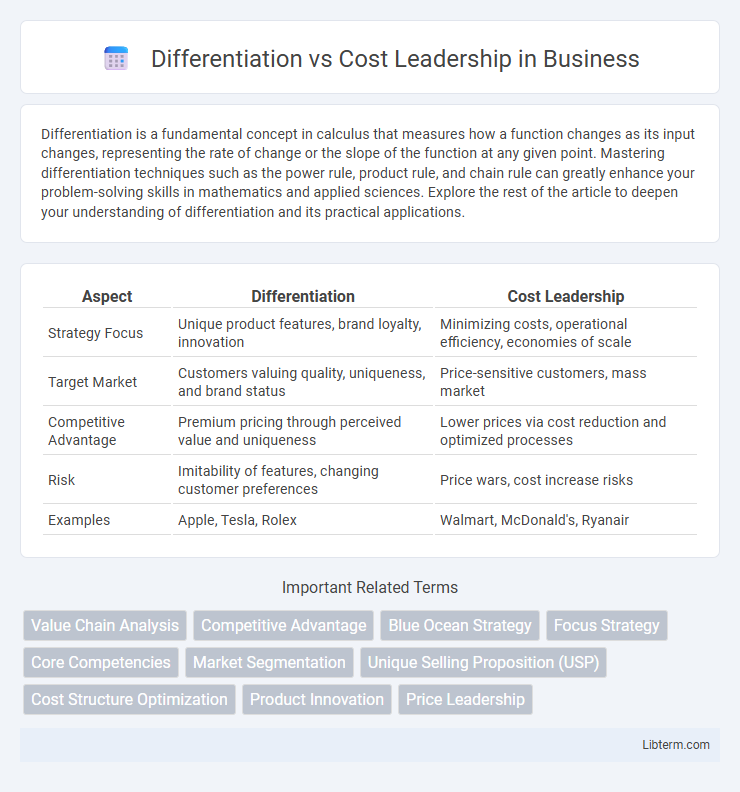Differentiation is a fundamental concept in calculus that measures how a function changes as its input changes, representing the rate of change or the slope of the function at any given point. Mastering differentiation techniques such as the power rule, product rule, and chain rule can greatly enhance your problem-solving skills in mathematics and applied sciences. Explore the rest of the article to deepen your understanding of differentiation and its practical applications.
Table of Comparison
| Aspect | Differentiation | Cost Leadership |
|---|---|---|
| Strategy Focus | Unique product features, brand loyalty, innovation | Minimizing costs, operational efficiency, economies of scale |
| Target Market | Customers valuing quality, uniqueness, and brand status | Price-sensitive customers, mass market |
| Competitive Advantage | Premium pricing through perceived value and uniqueness | Lower prices via cost reduction and optimized processes |
| Risk | Imitability of features, changing customer preferences | Price wars, cost increase risks |
| Examples | Apple, Tesla, Rolex | Walmart, McDonald's, Ryanair |
Understanding Differentiation and Cost Leadership
Differentiation involves creating unique products or services that offer distinct value to customers, enabling a company to charge premium prices and build brand loyalty. Cost leadership focuses on becoming the lowest-cost producer in the industry, allowing businesses to offer competitive prices while maintaining profitability. Understanding these strategies helps organizations align their resources and capabilities to achieve sustainable competitive advantage.
Key Concepts of Differentiation Strategy
Differentiation strategy centers on creating unique products or services that offer superior value through innovation, quality, or brand reputation, enabling businesses to charge premium prices. Key concepts include customer-centric customization, continuous innovation, and strong brand identity to build customer loyalty and reduce price sensitivity. This approach requires significant investment in research and development, marketing, and skilled talent to maintain competitive advantages.
Fundamentals of Cost Leadership Strategy
Cost leadership strategy emphasizes achieving the lowest production and operational costs within an industry to offer competitive pricing without sacrificing profitability. Core components include economies of scale, efficient supply chain management, and rigorous cost controls that reduce overhead and increase cost predictability. Firms employing cost leadership leverage standardized processes and high asset utilization to maintain sustainable cost advantages over competitors.
Core Differences: Differentiation vs Cost Leadership
Differentiation focuses on creating unique products or services that offer superior value through innovation, quality, or brand reputation, enabling premium pricing and customer loyalty. Cost leadership emphasizes achieving the lowest operational costs in the industry to offer competitive prices and capture market share. The core difference lies in differentiation targeting uniqueness and customer perception, while cost leadership prioritizes efficiency and cost minimization.
Advantages of Adopting Differentiation
Adopting differentiation allows firms to create unique products or services that command premium pricing and foster strong customer loyalty. This strategy reduces price sensitivity and mitigates competitive pressures by establishing a distinct brand identity and enhancing perceived value. Companies benefit from higher profit margins and increased market share in niche segments by leveraging innovation and tailored offerings.
Benefits of Implementing Cost Leadership
Cost leadership enables companies to achieve a competitive advantage by minimizing production and operational costs, allowing them to offer lower prices than competitors while maintaining profitability. This strategy attracts price-sensitive customers, expands market share, and creates barriers to entry for potential rivals. Efficient cost management also provides flexibility to withstand economic downturns and invest in innovation or marketing.
Risks Associated with Each Strategy
Differentiation strategy risks include high costs for innovation and marketing, potential imitation by competitors, and shifting customer preferences that reduce perceived uniqueness. Cost leadership risks involve aggressive price wars, thin profit margins, and the danger of compromising product quality, which can erode brand reputation. Both strategies demand continuous market analysis and operational efficiency to sustain competitive advantage and mitigate these inherent risks.
Industry Examples: Differentiation vs Cost Leadership
Apple exemplifies differentiation by offering innovative products with premium design and ecosystem integration, commanding higher prices through unique value. Walmart represents cost leadership by leveraging vast supply chains and economies of scale to provide everyday low prices and attract price-sensitive customers. Both strategies dominate their respective industries by targeting distinct consumer needs--Apple emphasizes quality and exclusivity, while Walmart prioritizes affordability and accessibility.
Choosing the Right Strategy for Your Business
Choosing the right strategy between differentiation and cost leadership hinges on your business's core competencies and market demands. Differentiation emphasizes unique product features, customer experience, and brand perception to justify premium pricing, ideal for companies targeting niche markets or innovation-driven sectors. Cost leadership focuses on operational efficiency, economies of scale, and cost reduction to offer competitive pricing, suitable for businesses operating in price-sensitive industries with high-volume sales.
Integrating Both Strategies: Is Hybrid Possible?
Integrating differentiation and cost leadership strategies can create a hybrid approach that leverages unique product features while maintaining competitive pricing. Companies like Toyota and Apple exemplify this hybrid by innovating in quality and design without exorbitant costs, enhancing market appeal and profitability. Achieving the right balance requires efficient operations, continuous innovation, and careful market segmentation to avoid strategic confusion and maximize value creation.
Differentiation Infographic

 libterm.com
libterm.com